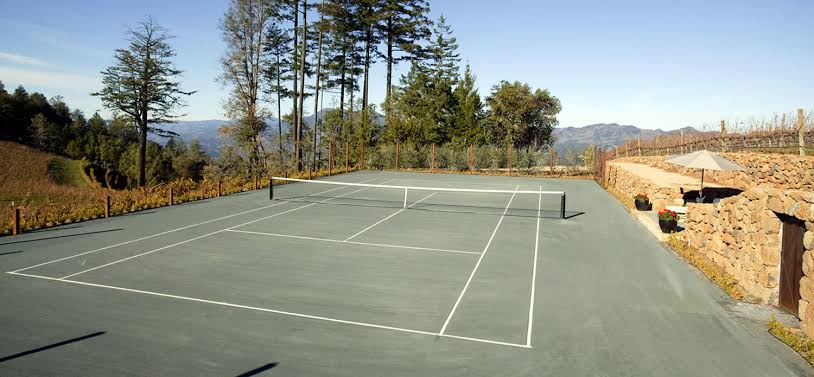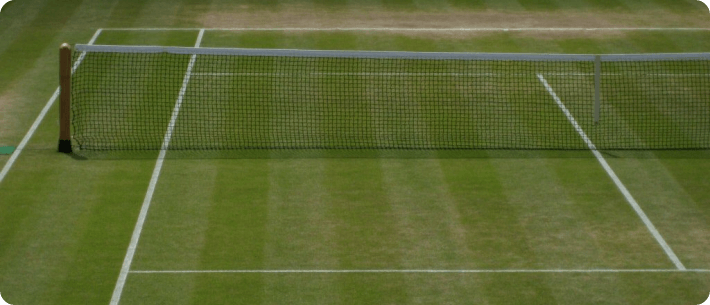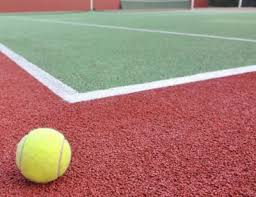Tennis is a popular racquet sport all over the world which is played individually between two opponents (Singles) or in pairs on both sides of the net as opponents known as Doubles. It’s playing area is called a tennis court that has mainly four types.
The tennis is played worldwide and attracts all age and gender types towards it. As kids, teenagers, adults involving males, and females equally take part in it.
If you are a starter or trying to improve your basic tennis equipment then you can check racquets, balls, shoe guides.
There are 211 ITF member countries globally, which shows its popularity. The Wimbledon Championships is the most popular tennis tournament among the Grand Slam tournaments of tennis along with the Australian Open, French Open, and US Open.
The ITF has approved 10 types of surfaces for tennis courts including Acrylic/Polyurethane, Artificial Clay, Artificial Grass, Asphalt, Carpet, Concrete, Grass, Hybrid Clay, and others (Modular Systems (tiles), Wood, Canvas, etc.).
Among these surfaces, four major tennis court surfaces(types) are used to construct a tennis court venue i.e. Clay Court, Carpet Court, Grass Court, and Hard Court.
Let’s have a quick look on all these tennis court types, tournaments, players, size, and dimensions.
Clay Court (Red Clay Court)
Until late 19th century 7 times Wimbledon champion player William Renshaw- came to save the tennis lawn grass from scorching while playing & sun-burning to pour powder of clay pots on the grass.
It became the first red tennis court and later it was amended.

It’s made of crushed small size stone, bricks shell, red brick dust or coal residue called clonker. It’s an easy and low-cost solution to play tennis but at the same time, it’s hard to maintain this as it costs more.
One of Grand Slam tournaments French Open tennis use this surface only. Once the US Open was also played on this from 1975-1977.
A reason that why this court is made up of shales or crushed stone is that it slows down the ball and bounce high as compared with other courts. That’s why it difficult for players to play on it. It’s popular in regions like Latin America, North America & Europe.
Green Clay Courts
Clay court and Green clay court are not only visually different but also have different conditions for players. This court is popular in USA (Eastern & Southern) and made form volcanic rock or crushed basalt.
Which tends to ball on this court travels or bounce faster. While the red clay court’s surface gripes the ball and bounce it back slowly.
Red clay courts are mostly found in the European region. Green clay court is branded as Har-Tru or Rubico as well in some regions.

As children grow up while playing on different surface courts. Which makes them strong or weaker on different types of surfaces. Accordingly, whether it’s green or red clay court for some people it has both advantages or disadvantages.
After the game, this court requires to maintain to brush to dislocated and redistribute it on court which makes surface dry. So to play better next time it’s watered to avoid cracking surface. Rolling is also helpful to keep surface smooth and in optimal condition.
Professional Tournaments & Players of the Clay Courts
It’s important to know that how many professional players play tournaments on this court to know it better.
Clay court’s professional/expert can be termed as one who had won the majority of titles on clay and play more drop shots as rallies on the court, push players away from baseline making them hard to play like other surfaces.
Clay Court Specialist Players
Some players are believed to be clay specialists like Rafael Nadal, Juan Carlos Ferrero, Thomas Muster, and Gustavo Kuerten. Other major clay court and French Open champions are Sergi Bruguera, Albert Costa, Justine Henin, and Gastón Gaudio.
Remember, Nadal is known as the king of the clay, the most French Open-clay title winner(men) in tennis history.
While few females players are there who have titles or good results in clay court. Chris Evert is the all-time Queen of the Clay while among active tennis players Serena Williams having three titles to her name.
Professional Grass Court Tournaments
Primarily three clay court seasons Winter Clay Season, Winter Clay Season, Spring Clay Season held in a year but not longer than hard court tournaments. Monte Carlo Rolex Masters, Barcelona Open, Rome Master and in Grand Slam the French Open as well are some examples.
Grass Tennis Court
Grass court is usually associated with Wimbledon Championship, the oldest championship in the tennis history. It is scheduled starting for two weeks starting from last Monday of June and ends in July’s first week.
Usually, Ladies & Gentlemen’s Singles finals are scheduled on Saturday and Sunday on the second and ending week of championship in July.
It’s one of the four types of tennis courts i.e. Clay, Hard, and Carpet. Formerly and originally know as Lawn Tennis court as it’s obvious. Grass is grown on hard soil and due to slippery grass, it’s faster than other courts.

The ball bounce is dependent on some variables like grass health, Trimming timing, and wear & tear after the latest matches played. Due to the Uneven surface of grass, it bounces unpredictably.
Although this court is considered fast but it’s also a fact that now-a-days Racquet Technology has changed the pace of game. As in the past when players used to play with wooden rackets, it tends to be interesting matches due to inconsistent grass surface.
Now new rackets are powerful than wooden which tends to end the match one-dimensional. Many surfaces have emerged recently as mentioned earlier which makes it difficult to play on grass.
It’s most popular in Britain and somehow exists in the Northeastern United States as well.
Maintenance & Cleaning of Grass Tennis Court
Grass is difficult to maintain as it involves many factors like growth, Humidity (Dew/Rain/Watering, etc.). It’s difficult to play when it rains and have to left it for the latest one day to become playable or use some suitable covers.

Most Successful Players on Grass Court
Despite the fact some players find it difficult to play on the grass court, the famous Spanish player Carlos Moya has commented that “Grass is for cows to eat, not for tennis”. He is a clay-court specialist.
Many players have performed wonders on these courts. Some most successful player whom everyone has at least have won 5 Grand Slam singles titles are Billie Jean King, Björn Borg, Chris Evert, Evonne Goolagong Cawley, John Newcombe, Margaret Court, Martina Navratilova, Novak Djokovic, Pete Sampras, Rod Laver, Roger Federer, Serena Williams, Steffi Graf and Venus Williams.
In females, Serena Williams reminded the most successful player by winning seven Wimbledon singles titles and her sister Venus Williams got five titles.
Roger Federer is considered the most successful player among males after Pete Sampras as he has won 19 titles on the grass-court in Open Era of tennis.
Professional Grass Court Tennis Tournaments
Many professional tennis tournaments are played on the grass courts including the Wimbledon Championships, Hall of Fame Tennis Championships, Stuttgart Open, Summer Season ATP 250 & 500, and WTA Mallorca tour.
These tournaments are short term consisting of week or 2 weeks time of game.
Hard Court
Hard court is a surface made up of concrete or asphalt-covered by an acrylic material to protect and lock the surface. Underneath the surface, sand is filled on top of concrete/asphalt.
Speed of ball lays between clay and grass courts and players tend to play on it of both surfaces. As the ball travels in between the speed of Grass and Clay courts and bounce is high and most importantly predictable-easy to control, obviously due to hard surface.

When the ball has high bounce then players are able to apply spin, so flat balls are used to play quick style. Bounce back speed depends on sand quantity and is reduced.
Tennis experts have the opinion that this court favors the players who have good serves and for baseliners.
How to Maintain Hard Court?
It is quite easy to maintain this court due to the controllability of surface and material that’s why many techniques are followed to keep this court running.
The goal of maintenance should be that playability of surface remains for a long time. It’s very common and easy to maintain court.

Hard Court Cleaning Methods & Suggestions
- No play while any debris is on the surface.
- The surface should be cleaned once in a week or before it breaks down by a clean sweep machine (Leaf Blower, Vacuum Machines & pedestrian power brushes, etc) and pressure washing to improve foot grip with cleaning solution. Anti Slip paints can also improve the safety and play quality.
- There should be algaecide and moss-killer sprays regularly on court and dead moss must be removed to avoid any winter sponge. Which can absorb water and while the low temperature can break asphalt up.
Professional Tennis Tournaments on Hard Court
From Grand Slams the Australian Open and US Open is played on hard courts. A Few try out or practice games are played in the USA as well.
Most Successful Players on Hard Court
Novak Djokovic and Roger Federer are considered the most successful players of the hard court from men in the singles category.
In females, most Grand Slam singles title(11) winner of the hard court is Margaret Court while all-time successful player is Steffi Graf with 37 hard court titles to her name.
WTA (Women Tennis Association) has announced power rankings for hard court based on an empirical formula. According to these rankings Angelique Kerber tops the list of five players.
Other female players are Agnieszka Radwanska, Simona Halep, Karolina Pliskova, Caroline Wozniacki are in list respectively.
Carpet Courts / Synthetic Court
It’s an indoor type tennis court where indoor events are organized. Carpet surface is defined by ITF (International Tennis Federation) as “The Textile surface of woven or non-woven (material) nylon, or a polymeric or rubber material, usually supplied in rolls or sheets”.
It’s a removable material cover which varies in terms of thickness & texture. According to material ball bounce varies fast to low resembling real grass courts. But these courts are banned by ATP in 2009 and by WTA in 2018.

Types of Carpet Court
This court falls in two categories i.e. Indoor & Outdoor. Indoor courts have the textile surface of rubber or nylon matting covering the concrete base. While outdoor court uses artificial turf filled with sand. Its became famous back in the 1980s due to low cost and easy to maintain as compared to grass.
International & Professional Tournaments
As discussed earlier it was banned from professional tournaments but back some years many tournaments used to play on it. For example, ECC Antwerp, Kremlin Cup, Paris Masters, U.S. Pro Indoor, WCT Finals and Zagreb Indoors used to play on these courts.
ATP banned this court due to increasing injury cases and criticism from professionals.
2020 Lakers Championship Ring – Standard Edition
LA Laker Sneaker is custom-designed for Los Angeles Lakers Fans. This Los Angeles Lakers sneaker shows off your fandom and love for Los Angeles Lakers. The best custom Los Angeles Lakers Sneakers for Los Angeles Lakers fans.
Conclusion
We have tried to brief you on four major types of a tennis court. For tennis court size and dimensions you can check the pos, It explains well all about making a tennis court.
Either you are all-court tennis player or one is your favorite tennis court type, and how is your experience? Please comment below.
If you want us to include additional information in this article then please inform us or contact us.


Like!! I blog frequently and I really thank you for your content. The article has truly spoken my interest about hard court shoes.
Grass court is my favorite! They decrease the chances of injury when slip while playing because I’m already facing a knee injury.
What do you think?
Well, Jack glad to know about your favorite, while it depends on individuals. Every court has its own pros and cons. Although there are chances of slippery at grass court as well.
before reading your blog I was no knowledge about the types of court. But after reading your blog I will get much knowledge about tennis and court
Hi!
This blog is very informative.
Because gave me new information about the types of court. Thanks.
You are welcome. We keep updating this article please keep visiting WimblednSport.com